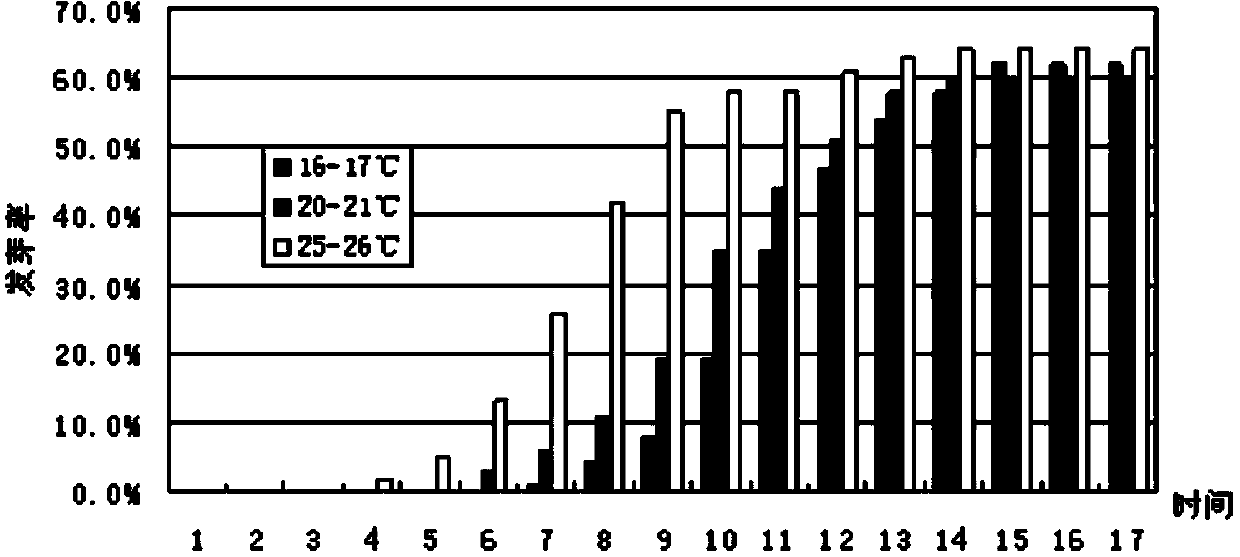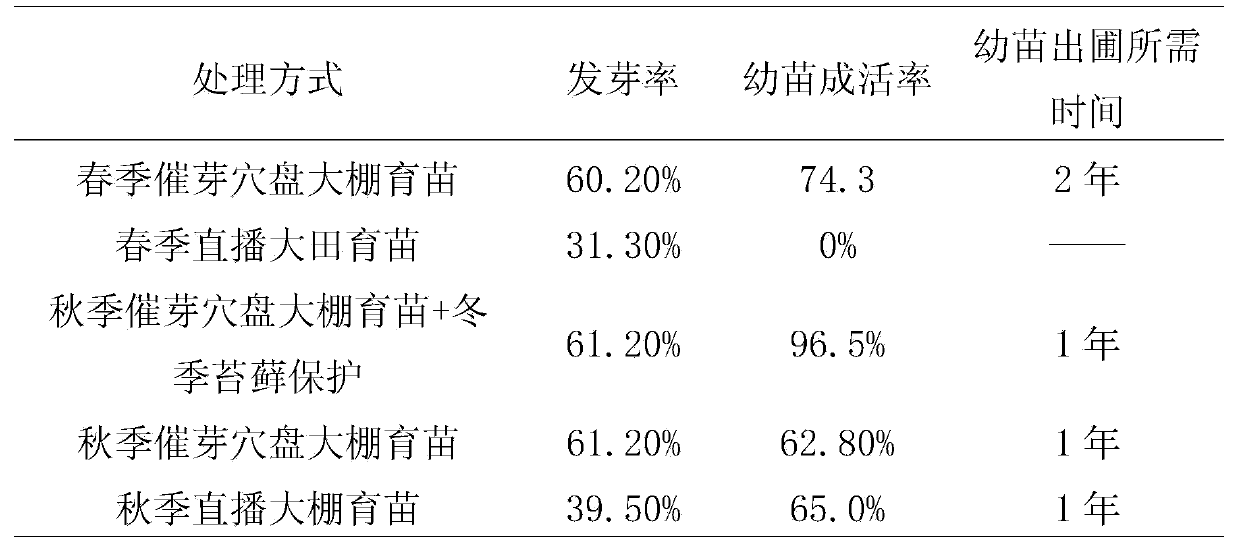Sowing and seedling raising method for mock orange
A technology for sowing and raising seedlings and japonica, which is applied in the field of plant seedlings in the agricultural field, can solve the problems of low reproductive rate of jasmine seeds, and achieve the effect of improving the survival rate
- Summary
- Abstract
- Description
- Claims
- Application Information
AI Technical Summary
Problems solved by technology
Method used
Image
Examples
Embodiment 1
[0025] Treatment of plug seedlings after germination in autumn
[0026] The full-bodied japonica seeds picked in October were germinated under laboratory conditions. Seeds are placed in germination boxes, which are divided into three germination boxes, with 200 seeds in each germination box and a weight of 0.033g. Seeds that were germinated in October were germinated at 20°C in consideration of the low temperature for overwintering. When the radicle of the seeds grew 0.2-0.3 cm, they were immediately transferred to a 108-mesh seedling tray. The substrate was peat soil, river sand, and pastoral soil. The ratio of 3:1:1 is fully mixed, and 3 days before transplanting seedlings, the ratio of 1:500 times of Dixon powder is mixed with water, stirred evenly, and then watered and disinfected. When transplanting seedlings, put the substrate into the seedling tray, the amount of substrate loaded is equal to the upper surface of the seedling tray, and put 1 seed in each hole. After the...
Embodiment 1
[0028] Treatment of Seedlings in Greenhouses in Spring after Germination
[0029] Put the plum blossom seeds collected in autumn in paper bags to overwinter at room temperature, and germinate at the end of March next year. Seeds are placed in germination boxes, which are divided into three germination boxes, with 200 seeds in each germination box and a weight of 0.033g. Accelerate germination at 20°C, and when the radicle of the seed grows 0.2-0.3cm, immediately transfer it to a 108-mesh seedling tray. The substrate is fully mixed with peat soil, river sand, and garden soil in a volume ratio of 3:1:1. 3 days before transplanting seedlings, use Dixon powder in a ratio of 1:500 times and mix with water evenly, then water and disinfect. When transplanting seedlings, put the substrate into the seedling tray, the amount of substrate loaded is equal to the upper surface of the seedling tray, and put 1 seed in each hole. After the transfer, use a sprayer to spray atomized water on t...
Embodiment 2
[0031] Greenhouse seedling raising method for direct seeding in autumn
[0032]In October, weigh 0.1 grams of seeds, mix them with 200ml of fine dry sand, and spread them in the seedling trays. The seedling substrates are fully mixed with peat soil, river sand, and pastoral soil in a volume ratio of 3:1:1. After the substrate is sterilized with 500 times of carbendazim, it is sown. After sowing, it is covered with sandy soil of about 0.1 cm, and sprayed with atomized water until water seeps out of the water hole under the seedling tray, and the seedling substrate is fully soaked. Then put the soaked seedling tray directly into the plastic greenhouse. At this time, the temperature of the plastic greenhouse generally fluctuates around 16-20°C. Seeds began to germinate on the 10th day after sowing, and no more seeds germinated after 20 days. After 20 days, the statistical germination rate was only 39.5%. The seedlings survive the winter in the greenhouse. Due to the low temper...
PUM
 Login to View More
Login to View More Abstract
Description
Claims
Application Information
 Login to View More
Login to View More - R&D
- Intellectual Property
- Life Sciences
- Materials
- Tech Scout
- Unparalleled Data Quality
- Higher Quality Content
- 60% Fewer Hallucinations
Browse by: Latest US Patents, China's latest patents, Technical Efficacy Thesaurus, Application Domain, Technology Topic, Popular Technical Reports.
© 2025 PatSnap. All rights reserved.Legal|Privacy policy|Modern Slavery Act Transparency Statement|Sitemap|About US| Contact US: help@patsnap.com


